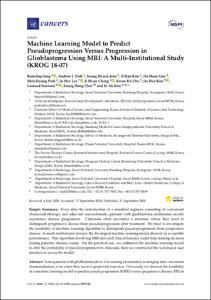KUMEL Repository
1. Journal Papers (연구논문)
1. School of Medicine (의과대학)
Dept. of Radiation Oncology (방사선종양학)
Machine Learning Model to Predict Pseudoprogression Versus Progression in Glioblastoma Using MRI: A Multi-Institutional Study (KROG 18-07)
- Keimyung Author(s)
- Kim, Jin Hee
- Department
- Dept. of Radiation Oncology (방사선종양학)
- Journal Title
- Cancers
- Issued Date
- 2020
- Volume
- 12
- Issue
- 9
- Abstract
- Simple Summary:
Even after the introduction of a standard regimen consisting of concurrent chemoradiotherapy and adjuvant temozolomide, patients with glioblastoma multiforme mostly experience disease progression. Clinicians often encounter a situation where they need to distinguish progressive disease from pseudoprogression after treatment. We tried to investigate the feasibility of machine learning algorithm to distinguish pseudoprogression from progressive disease. In multi-institutional dataset, the developed machine learning model showed an acceptable performance. This algorithm involving MRI data and clinical features could help making decision during patients' disease course. For the practical use, we calibrated the machine learning model to offer the probability of pseudoprogression to clinicians, then we constructed the web-based user interface to access the model.
Abstract:
Some patients with glioblastoma show a worsening presentation in imaging after concurrent chemoradiation, even when they receive gross total resection. Previously, we showed the feasibility of a machine learning model to predict pseudoprogression (PsPD) versus progressive disease (PD) in glioblastoma patients. The previous model was based on the dataset from two institutions (termed as the Seoul National University Hospital (SNUH) dataset, N = 78). To test this model in a larger dataset, we collected cases from multiple institutions that raised the problem of PsPD vs. PD diagnosis in clinics (Korean Radiation Oncology Group (KROG) dataset, N = 104). The dataset was composed of brain MR images and clinical information. We tested the previous model in the KROG dataset; however, that model showed limited performance. After hyperparameter optimization, we developed a deep learning model based on the whole dataset (N = 182). The 10-fold cross validation revealed that the micro-average area under the precision-recall curve (AUPRC) was 0.86. The calibration model was constructed to estimate the interpretable probability directly from the model output. After calibration, the final model offers clinical probability in a web-user interface.
- Keimyung Author(s)(Kor)
- 김진희
- Publisher
- School of Medicine (의과대학)
- Citation
- Bum-Sup Jang et al. (2020). Machine Learning Model to Predict Pseudoprogression Versus Progression in Glioblastoma Using MRI: A Multi-Institutional Study (KROG 18-07). Cancers, 12(9), 2706. doi: 10.3390/cancers12092706
- Type
- Article
- ISSN
- 2072-6694
- Source
- https://www.mdpi.com/2072-6694/12/9/2706
- Appears in Collections:
- 1. School of Medicine (의과대학) > Dept. of Radiation Oncology (방사선종양학)
- 파일 목록
-
-
Download
 oak-2020-0229.pdf
기타 데이터 / 2.99 MB / Adobe PDF
oak-2020-0229.pdf
기타 데이터 / 2.99 MB / Adobe PDF
-
Items in Repository are protected by copyright, with all rights reserved, unless otherwise indicated.